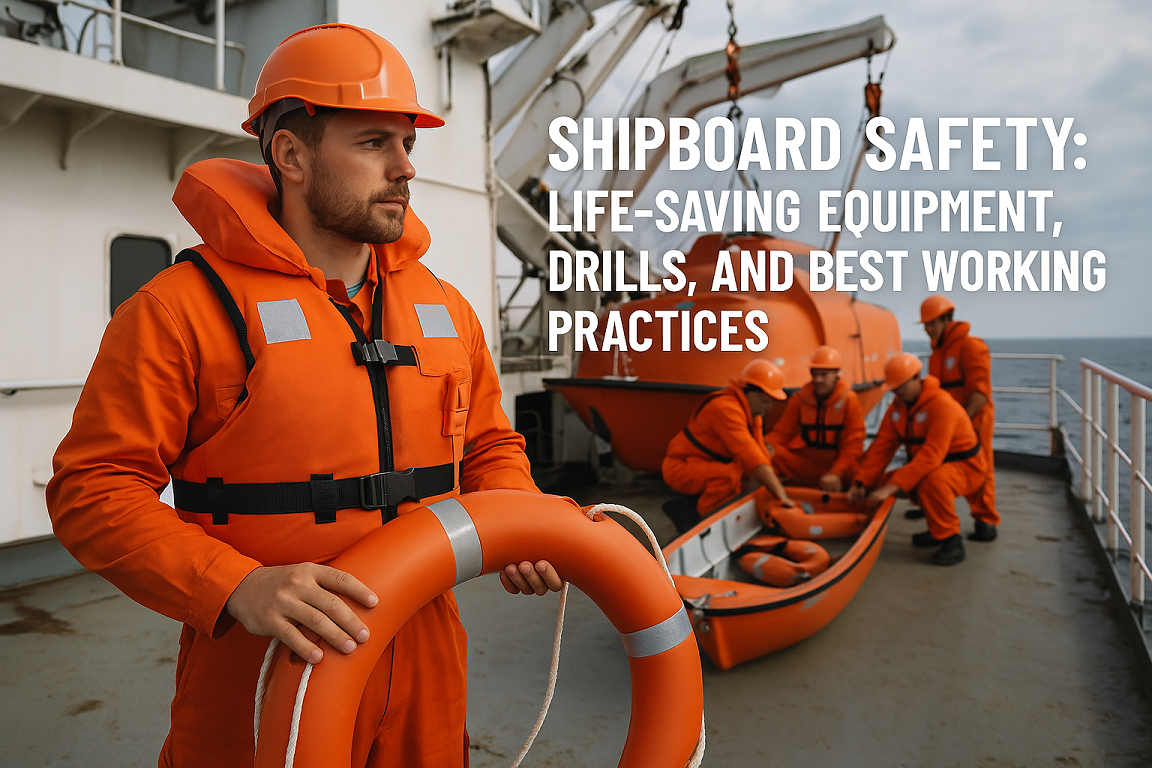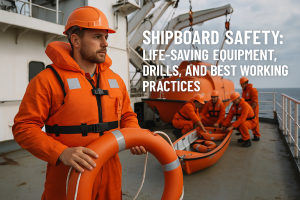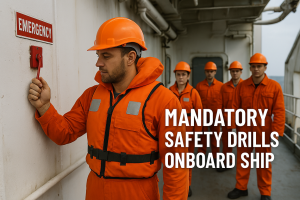Explore essential shipboard safety measures, life-saving equipment, mandatory drills, and best working practices for seafarers. A complete safety guide for maritime students, cadets, officers, and shipping professionals.
🚢 Your Safety is No Accident at Sea
Life at sea is full of adventure—but also full of risks. From heavy machinery to harsh weather, the shipboard environment demands constant awareness and preparedness. That’s why shipboard safety, life-saving appliances, and mandatory safety drills are the backbone of maritime operations.
Whether you’re a cadet on your first voyage or a chief officer managing crew routines, this guide will walk you through what really keeps people safe on board.
⚓ What Is Shipboard Safety?
Shipboard safety refers to all the practices, procedures, equipment, and behavior standards designed to protect seafarers, passengers, cargo, and the vessel itself from harm while at sea or in port.
This includes:
-
Life-saving appliances (LSA)
-
Firefighting equipment (FFE)
-
Safety drills and emergency training
-
Safe working practices and hazard awareness
🛟 Life-Saving Equipment Onboard Ships (LSA)
The LSA Code, part of SOLAS Chapter III, outlines all life-saving appliances required onboard. These include:
1. Lifeboats and Rescue Boats
- Enclosed or partially enclosed types
- Located on both port and starboard sides
- Must accommodate all persons onboard
2. Life Rafts
- Inflatable, automatically released or manually launched
- Include survival packs (water, rations, signaling gear)
3. Life Jackets and Immersion Suits
- One lifejacket per person + extras
- Suits provide thermal protection in cold waters
4. EPIRB (Emergency Position Indicating Radio Beacon)
-
Sends location to rescue authorities upon activation
5. SART (Search and Rescue Transponder)
-
Helps rescuers locate life rafts and lifeboats via radar
6. Pyrotechnics
-
Rocket parachute flares, hand flares, and smoke signals for distress communication
“Every piece of life-saving gear is useless unless the crew knows how to use it.” – ISM Safety Principle
🧯 Firefighting and Emergency Equipment
-
Portable fire extinguishers (Foam, CO₂, Dry Powder)
-
Fixed firefighting systems (CO₂ flooding, water mist)
-
Fire hydrants and hoses
-
Emergency fire pump
-
Fireman’s outfit (helmet, boots, gloves, breathing apparatus)
🔁 Mandatory Safety Drills Onboard
As per SOLAS Chapter III, Regulation 19, drills must be carried out regularly and include:
1. Abandon Ship Drill
- Weekly muster + monthly full drill
- All crew must don lifejackets and proceed to muster stations
2. Fire Drill
- At least once every month
- Includes emergency response, fire isolation, and use of firefighting systems
3. Man Overboard Drill
- Simulates retrieving a person from the sea
- Use of MOB markers, lifebuoys, rescue boat launch
4. Emergency Steering Gear Drill
- Required once every three months
- Operation from the steering gear compartment with communication to the bridge
5. Enclosed Space Entry Drill
- Practiced every two months
- Ensures crew is trained in rescue and resuscitation techniques
👷 Best Working Practices Onboard
✅ Personal Safety
-
Always wear PPE (helmet, safety shoes, gloves, goggles)
-
Maintain a clean, dry deck to prevent slips and falls
-
Use fall protection gear when working at heights
✅ Machinery and Electrical Safety
-
Follow lock-out/tag-out procedures
-
Never bypass alarms or safety interlocks
-
Check for hot surfaces, rotating parts, and high-voltage equipment
✅ Watchkeeping and Bridge Safety
-
Follow Bridge Resource Management (BRM) principles
-
Never leave the bridge unattended
-
Use proper Standard Marine Communication Phrases (SMCP)
✅ Health and Mental Wellness
-
Maintain adequate rest hours under MLC
-
Report any stress or fatigue issues
-
Encourage open communication and support among crew
📈 Latest Trends & Best Practices
-
Digital Safety Tools: Wearables, smart helmets, and real-time tracking systems
-
Green Safety Practices: Eco-friendly firefighting foam, electric lifeboats
-
Mental Health Awareness: Increasing focus post-COVID-19 pandemic
-
Virtual Reality (VR) Drills: Interactive training simulations for cadets and officers
🔎 FAQs – Shipboard Safety
Q1: What is LSA on ships?
A1: LSA stands for Life-Saving Appliances, including lifeboats, rafts, jackets, EPIRBs, and pyrotechnics.
Q2: How often are safety drills conducted onboard?
A2: Fire and abandon ship drills monthly; steering gear drills every three months; enclosed space entry drills every two months.
Q3: What are some examples of personal protective equipment (PPE) onboard?
A3: Helmet, safety shoes, gloves, eye protection, coveralls, and hearing protection.
Q4: Are safety drills mandatory for every voyage?
A4: Yes, steering gear must be tested within 12 hours before departure, and other drills must follow SOLAS schedules.
Q5: What is the difference between FFE and LSA?
A5: FFE (Fire Fighting Equipment) is for fire response; LSA (Life-Saving Appliances) is for rescue and survival.
📚 References & Further Reading
✅ Conclusion: Safety at Sea Is Everyone’s Responsibility
Whether you’re a junior cadet or a ship captain, safety is not optional—it’s a daily practice. Regular drills, working knowledge of life-saving equipment, and following best practices help prevent accidents and save lives.




I couldn’t resist commenting. Well written!
Pretty nice post. I simply stumbled upon your blog and wished
to say that I have really loved surfing around your weblog posts.
After all I will be subscribing in your feed and I hope you write once more soon!
I savor, result in I found exactly what I was having a look for.
You have ended my four day long hunt! God Bless you
man. Have a great day. Bye
Thank you for the auspicious writeup. It in fact was a amusement account it.
Look advanced to more added agreeable from you! By the way,
how could we communicate?
We are a bunch of volunteers and opening a brand new scheme in our community.
Your website provided us with helpful information to
work on. You have performed a formidable job and our
entire neighborhood can be thankful to you.
Nice blog here! Also your website a lot up fast! What web host are you
using? Can I get your associate hyperlink in your host?
I want my web site loaded up as fast as yours lol
Thanks for the article.
Thanks for the article
Thanks for the article
Thanks for the article
Website https://cardsfm.ru/ .